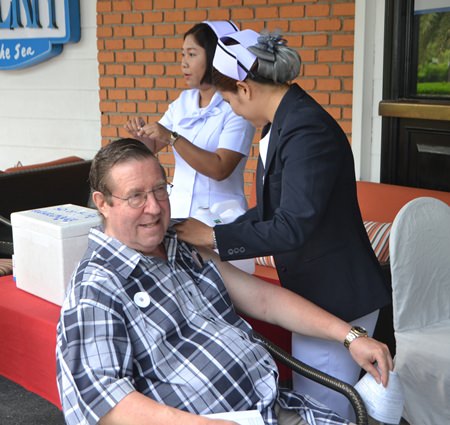The emcee, Roy Albiston, promised that it would be a talk that you could “sink your teeth into.” He was referring to an address on tooth replacement options at last Sunday’s meeting by Dr Thanyathorn Srimongkolkul, a dentist from Phyathai Hospital Sriracha. Tooth be told, Dr Thanyathorn did not disappoint. She spoke in fluent English and didn’t gum it up once.
There are three ways to repair a chipped or broken tooth, Dr Thanyathorn explained: dental filling; dental cap or crown; and dental veneer. Dental filling involves the use of a filling, something most of us are familiar with, though these days a tooth-coloured composite resin is used in place of the amalgams many of us received in the past.
 Dr. Thanyathorn explains the various methods of tooth replacement and the type of care needed for each type to her PCEC audience.
Dr. Thanyathorn explains the various methods of tooth replacement and the type of care needed for each type to her PCEC audience.
A dental crown is used when a large piece of tooth breaks off or the tooth has a lot of decay. There are several materials uses: all metal, all ceramic, and porcelain (which is kind of a hybrid between metal and ceramic). Each material has its advantages and disadvantages, Dr Thanyathorn noted. The all metal does not look good, so many dentists use it on the teeth at the back of the mouth. The all ceramic looks just like normal teeth, but does not last as long. The porcelain is very strong and fits very precisely, but requires more tooth reduction and may wear down opposing teeth. Further that for front teeth, dental veneer – a thin shell of tooth-coloured porcelain or resin composite is also used.
If you are missing a tooth, there are good reasons for replacing it. Not replacing it can cause bone loss in the cavity and can cause adjacent and opposite teeth to drift. There are three options for replacing a tooth: a dental implant; a fixed bridge; and a removable partial denture.
Dr Thanyathorn mentioned that a dental implant is placed in the jaw; there must be enough bone to support it. The advantages of implants are that they look like other teeth; they last for years; and some kinds of implants require just one or two visits to the dentist. The disadvantages are that it involves a surgical procedure and it costs more than other treatments.
 Gavin Waddell, International Marketing Executive for Phyathai Hospital Sriracha provides information on the dental services offered by the hospital and how those wishing a consultation with Dr. Thanyathorn can arrange for an appointment.
Gavin Waddell, International Marketing Executive for Phyathai Hospital Sriracha provides information on the dental services offered by the hospital and how those wishing a consultation with Dr. Thanyathorn can arrange for an appointment.
A fixed bridge can be used to fill the space where one or more teeth have been lost. The bridge is bonded or cemented in place. It’s cheaper than an implant, and looks, feels and functions like natural teeth. But it is more expensive than a denture and it can negatively affect the teeth next to the bridge. A fixed bridge also requires cleaning in the hollow space below the bridge.
Dr Thanyathorn further explained that removable dentures can easily be taken out of the mouth for cleaning, and usually come with a plastic base that matches the colour of your gums. But dentures are less stable than the alternatives and they can be uncomfortable. They may also need to be replaced more frequently than the other options.
 Member David Garmaise was one of 47 members and guests that obtained their annual flu vaccination from one of the Phyathai Hospital Sriracha nurses during the weekly PCEC meeting on October 18.
Member David Garmaise was one of 47 members and guests that obtained their annual flu vaccination from one of the Phyathai Hospital Sriracha nurses during the weekly PCEC meeting on October 18.
Dr Thanyathorn described how to care for your teeth for all of the options she described in her talk. She also answered several questions from the audience at the end of her presentation.
After the presentation, MC Roy Albiston brought everyone up to date on upcoming events and called on Al Sarrato to conduct the Open Forum, where questions are asked and answered about Expat living in Thailand, especially Pattaya.
For more information on the PCEC’s many activities, visit their website at www.pcecclub.org.




